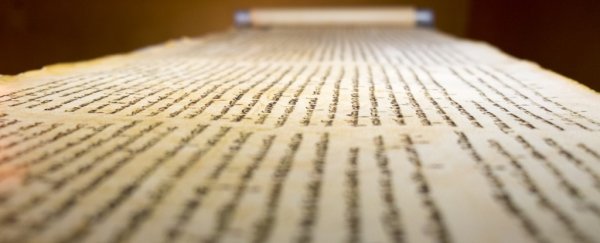Ever since they were discovered some 70 years ago, the Dead Sea Scrolls have fascinated scholars and historians. But the precise origins and authorship of these ancient texts have always been shrouded in mystery.
Now, an analysis of more than 30 newly discovered graves could give us our best clue yet on how these relics were ushered into modern history.
The manuscripts – which inscribe some of the oldest known foundations of the Old Testament – were first discovered by shepherds in caves in Qumran, an archaeological region in the West Bank along the northwestern shore of the Dead Sea.
Inside a series of caves, incredibly preserved scrolls were found dating back to around 2,000 years ago. It took them a decade, but researchers ultimately assembled the scrolls into a collection of 981 manuscripts.
Ever since the discovery, various explanations have been suggested as to who created or oversaw the Dead Sea Scrolls - including soldiers, craftsmen, people from the Iron Age, or Bedouins.
One of the most established hypotheses was that the texts were linked to an ancient Jewish sect called the Essenes. Now a new analysis of 33 skeletons excavated in Qumran just last year adds a lot of weight to that argument.
Anthropologists from the Israel Antiquities Authority examined the ancient bones, with radiocarbon dating showing the remains dated to about 2,200 years ago – the same age as the Dead Sea Scrolls, which are thought to have been penned between 200 BCE and 100 CE.
But while the age of the skeletons links them to when the Dead Sea Scrolls were created, even more compelling are other identifying features of these long-buried bones.
Of the 33 skeletons found, at least 30 were identified as being probably or definitely men, based on factors such as pelvic shape and body size – and the other bones may have belonged to men too, although not enough skeletal evidence remains to be sure.
Although questions remain, that commonality is highly suggestive that these ancient skeletons were once members of the enigmatic Essenes, the team thinks.
"I don't know if these were the people who produced the Qumran region's Dead Sea Scrolls," one of the researchers, Yossi Nagar, told ScienceNews.
"But the high concentration of adult males of various ages buried at Qumran is similar to what has been found at cemeteries connected to Byzantine monasteries."
At the time of their deaths, the men buried would have been between 20 and 50 years old. Given how old some of these men were – and the lack of evidence of any war-related injuries to their bones – it looks like they couldn't have been soldiers.
Since there appear to be no women among the burials, the researchers suggest it's probable we're looking at a "community of ideologically celibate men… child proportion and adult age at death distribution match the common desert monasteric societies of the subsequent periods".
Of course, we can't take this hypothesis as proven just yet. And even if it were, we still wouldn't know if the Essenes – if that's who these men were – were the authors of the Dead Sea Scrolls, or merely caretakers who acted as custodians for important documents like biblical manuscripts.
But it's a big clue that might help us get closer one day to understanding just who had a hand in writing the Dead Sea Scrolls, which are often cited as being one of the most important archaeological finds of the 20th century.
The findings were presented at the annual meeting of the American Schools of Oriental Research in Boston, Massachusetts, last week.
